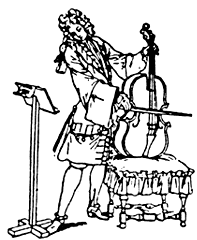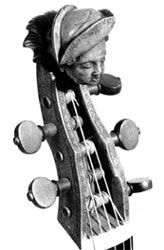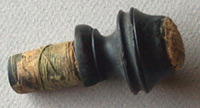

In the middle of the 16th century,Andrea Amati from the Cremona school set the standard of the violin as we know it today. It comes from two families; the family of vielles, a popular instrument played on the shoulder, and the family of the aristocratic viols played on the knees, like the cello. The violin's rise in popularity has been difficult since the court musician played on crudely made instruments of the people. At the time, music was often religious, the church was strongly linked with the aristocratic world. This lobbying encouraged the promotion of the violin. Italy brillantly supported the violin whereas in France, they disadvantaged the cello. Another involuntary support to the accession of the violin in France was during the fashion of the "Bergeries" and rural music at the court of Versailles. The first official sign of recognition of this instrument was that the King's group, which had 24 violins, played to welcome and support the merrymaking of the hunters return. |
 | |
| The tendances for the divine, mythololical sources, sentimentality and all ritualising activities of the baroque period, have provided a perfect setting for the expression of the violin.
Once the aristocracy found a need for that instrument, they offered the wherewithal to it's merit. They thereafter sponsored composers, concerts, danse and musical activities, the making and the playing of the violin, and encouraged commerce which created strong artistic links in Europe. Cultural development became universal for the aristocratical community of the ancient continent.
| ||
The respect for the old instrument didn't exist; the notion of antiques did'nt exist. How many instruments became out of fashion at the time, only to reappear transformed into other instruments later on: baroque guitars transformed into a hurdy-gurdy or the rough cutting of a viol became a tailored cello. If a luthier has a personnal knowledge, it would be the ability to choose wood. Myths are strong and many of the woods used at the time where not that nice: "I've seen a violin top where an original repair was hiding a pocket of resin, and even a big wooden knot at the back of an instrument". The reverance we give to the drying of the wood didn't exist in early time since with the dendrochronology we can date it to the exact year and we know that dated instruments were made with wood cut from tree only fifteen years before! It is very wise to practice a drying period for the wood but it certainly isn't an ancient wisdom. Stradivarius, Stradivarius, also from the school of Cremona made all sorts of instruments apart from the Quatuor such as : harps, guitars, (cistres).. The stinged instrument makers of the 18th century made all sorts of instruments, unlike today when the makers have their own facilities to specialise. |
The musical practice of the baroque period was the privilege of the upperclasses, the ones that can afford to take dance classes or to financially support a musician. Beyond that way of passing their time, music was a way to express themes of the period such as; beauty, love, divine power… The musician never added his own personality, but he simply transmitted the music to his fellowmen of that inaccessible sentimentalist pursuit. Manichaeanism?. Several tutor books of the 18th century devote a chapter to the expression of a musician. They don't have much to say about the position of the body: one must imperatively carry one's head in a upright majestic position, the mouth and the eyes must be relaxed, without expression. " I think of the lockjawed smile that the accordeon player keeps hold of while playing a long evening in a dance hall in spite of the weight of the instrument cutting into his shoulder !" The violin player whose position is as uncomfortable, has to make the sound and the texture of his note and also to suffer from his unatural painful position. They didn't do anything about it in the 18th century , when the playing position was less standard, the personal touch less noticeable and also less constrained by the way of the technical brillance which was to be the privilege of the following century. |
One doesn't find many accessories in this period. Chinrest and endpins didn't exist yet because the playing position was not established. On the ancient instrument that we've seen, pegs, tailpiece have been worn out, they've been changed many times over and there are no more original ones or else they are anonymus however, there is still a way for discovering them. Museums haven't kept the best pieces like those very ornate collectors instruments, those covered with ivory and mother of pearl or those who have been ordered for shop windows and consequently rarely played. They remain therefore in better condition today. The most authentic accessories werealso used on the out of fashion instruments such as the baroque guitar, hurdy gurdy, viola d'amore. This suggest that one can find supposedly original pegs and tailpiece on these instruments. |
 Viol's head 1753 | |
| PEGS If the turning of ordinary early pegs is always rustic with no finish, one has to remember that sanding was a rare practice. Their look is a bit rough, but they had personality, resulting from the chiseling which showed the skill of the turner. The pegs head had flat sides with an overall rounded shape, leaving breathing space between the ring and the cone. The ends of the head often had two fine grooves at their widest part. Very often the head carries a button or a white pip in bone. | ||
 Violone peg, fruit tree |
 French violin 18th Boxwood. |  English violin peg Boxwood . |
 French cello peg (old Paris). |
|||
Tailpieces The baroque tailpiece is a very light trapeziform small plank in wood (less than 10 grammes or 1/3 ounce- violin), of which the top is slightly rounded. The two outside strings E and G make an angle turning flatter than the two other ones on the bridge. On the modern violin, this curve is rounder, identical to the curve of the bridge.The turning is more regular just as the pressure of each string is on the bridge. Before this precious wood was imported, a fine veneered white wood covered the tailpiece. |
||||||
 An engraved baroque tailpiece |
 Stradivarius tailpiece 1716 |
CHINREST |
The chinrest still unknown. The First chinrest ??(Sienne 1433) photo ch.Rault |
ENDPIN |
The endpin still unknown. Baroque cello button . Ebony with a cork stopper |